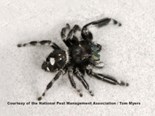Need assistance? Call 800.996.4402

About 300 species of jumping spiders are found in the United States and Canada. Unlike most spiders, jumping spiders are active during the daytime and seem to like sunshine.
Jumping spiders do not construct snare webs but do build web retreats which are loosely woven, saclike, composed of several envelopes and usually have two openings. Unlike most spiders, jumping spiders are active during the daytime and seem to like sunshine. They are hunters and have the keenest vision of all spiders, being able to detect and react to movement up to 18″ in distance; however their night vision is very poor. They can rapidly move both sideways and backwards for short distances. As their name implies, they are excellent jumpers.
While they can bite, the jumping spider bite is not poisonous. They are not considered dangerous.
Retreats may be built under furniture, in drapery folds, between books on bookshelves, in cracks found in wood floors, around door and window molding, etc. Outside retreats may be found under loose bark, between leaves, etc. Indoors, spiders will usually be found hunting around windows and doors because more insects are attracted to these areas and their vision is best in sunlit areas. Outdoors, jumping spiders are commonly seen running over tree bark, under stones and boards, on bushes, fences, decks and the outside of buildings, especially sunny areas.
Need to know how to get rid of jumping spiders? In addition to sealing cracks and screening doors and windows, exclusion and the removal of outdoor harborages is key. Indoors, removal with a vacuum is best followed by disposal of the vacuum bag outside.
For the very best food safety consulting, auditing and training, please visit our strategic partner, CFS Food Safety